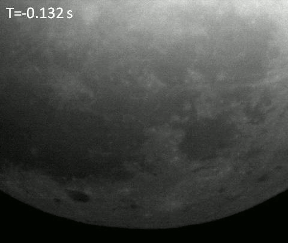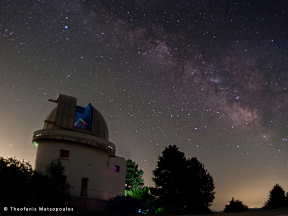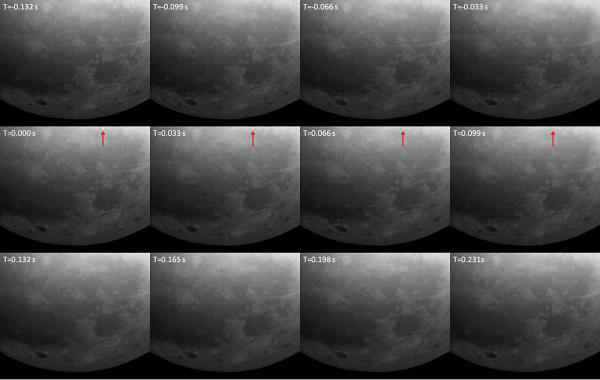New NELIOTA project detects flashes from lunar impacts
24 May 2017
Using a system developed under an ESA contract, the Greek NELIOTA project has begun to detect flashes of light caused by small pieces of rock striking the Moon's surface. NELIOTA is the first system that can determine the temperature of these impact flashes. |
| Lunar impact flash. Credit: NELIOTA project |
Studies such as NELIOTA are important because Earth and its Moon are constantly bombarded by natural space debris. Most of this material ranges in size from dust particles to small pebbles, although larger objects can appear, unexpectedly, from time to time. This was the case when an object almost 20 m in diameter disintegrated above the Russian city of Chelyabinsk in February 2013. The resultant explosion, caught on camera, caused considerable damage, although, fortunately, no one was killed.
Particles only millimetres across usually appear several times per hour on any clear dark night in the form of meteors or 'shooting stars'. However, the number of incoming objects in the size range from decimetres to metres is not well known. Too small to be detected directly with telescopes, they are rarely captured by cameras when they enter Earth's atmosphere.
One way to determine the number of larger impactors and the potential impact threat to Earth is to observe the Moon, in particular the dark area not illuminated by the Sun. When small asteroids strike the lunar surface at high speed, they burn up on impact, generating a brief flash of light, which can be visible from Earth. Assuming a typical velocity and density, the size and mass of the object can be estimated from the brightness of the event.
 |
| Kryoneri Observatory, Greece. Credit: Theofanis Matsopoulos |
A new campaign to study these lunar flashes is being undertaken by the NELIOTA (Near-Earth object Lunar Impacts and Optical TrAnsients) project, which began operation on 8 March 2017. NELIOTA utilises a refurbished telescope, which is operated by the National Observatory of Athens and located close to the Greek town of Kryoneri.
The 1.2 m telescope splits incoming light into two colours and uses two advanced digital cameras to record the data at a rate of 30 frames per second. Observations of the Moon's night hemisphere are made whenever Earth's natural satellite is above the horizon and mainly dark – between New Moon and the first quarter phase, or between last quarter and New Moon.
Automated software analyses the video obtained and identifies possible impact flashes. Camera effects can be excluded by identifying events that are only visible in both cameras. The cameras operate in different colour ranges, allowing the temperature of the impact flash to be estimated – NELIOTA is the first system of this type to have the potential to determine the temperature of these flashes.
The exceptional capability of the telescope was confirmed during its pre-operational, commissioning phase, when it recorded four impact flashes in about 11 hours of observing time. The task is now to observe these flashes on the dark side of the Moon over a period of 22 months.
 |
| Lunar impact flash. Credit: NELIOTA project |
"Its large telescope aperture enables NELIOTA to detect fainter flashes than other lunar monitoring surveys and provides precise colour information not currently available from other projects," says Alceste Bonanos, the Principal Investigator for NELIOTA.
"Our twin camera system allows us to confirm lunar impact events with a single telescope, something that has not been done before. Once data have been collected over the 22-month long operational period, we will be able to better constrain the number of NEOs (near-Earth objects) in the decimetre to metre size range.
"The data will also help to determine the physics of impact flashes. We are analysing the flashes in collaboration with the Science Support Office of ESA, in order to measure the temperature of each flash and estimate the mass, size of the impactor and crater size created from the impact."
"These observations are very relevant for our Space Situational Awareness programme. In particular, in the size range we can observe here, the number of objects is not very well known. Performing these observations over a longer period of time will help us to better understand this number," says Detlef Koschny, co-manager of the near-Earth object segment in ESA's Space Situational Awareness programme, and a scientist in the Science Support Office.
NELIOTA is also contributing to public outreach and education.
"We are currently training two PhD students to operate the Kryoneri telescope and conduct lunar monitoring observations," says Alceste.
"We also organise public tours of Kryoneri Observatory, during which we present the NELIOTA project, as well as talks on near-Earth asteroids for students and for the general public. This year, we plan to participate in Asteroid Day 2017, by organising a public event at Kryoneri Observatory on 30 June."
Background information
The National Observatory of Athens developed and operates NELIOTA. It is funded through a contract with ESA's Science Directorate.
The NELIOTA website (http://neliota.astro.noa.gr/) provides the observational characteristics of the flashes (time, duration, magnitude, coordinates) within 24 hours of the observations.
Following its upgrade in 2016 for the NELIOTA project, the Kryoneri telescope is mainly used for lunar monitoring. It is also contributing to follow-up photometry of transient events, such as those detected by ESA's Gaia mission, as well as asteroid occultations.
One of the dangers humans on the Moon would face is that a small asteroid could damage their infrastructure – NELIOTA will help estimate the danger from such small asteroids. As the Moon doesn't have an atmosphere, it cannot block the smaller – but still dangerous – objects. It is likely that permanent structures on the Moon will be underground, to provide better shielding from both small asteroids or meteoroids and solar radiation.
Contacts
Alceste Bonanos, NELIOTA Principal Investigator
Institute for Astronomy, Astrophysics, Space Applications and Remote Sensing
National Observatory of Athens
Greece
Phone: +30 210 8109177
Email: bonanos![]() astro.noa.gr
astro.noa.gr
Detlef Koschny, SSA-NEO co-manager
Directorate of Science
European Space Agency
Email: Detlef.Koschny![]() esa.int
esa.int
Vicente Navarro, NELIOTA Technical Officer
Directorate of Science
European Space Agency
Email: Vicente.Navarro![]() esa.int
esa.int



